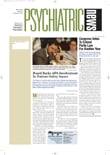Mental health representatives from 20 states will be trained at regional workshops next year in how to use promising alternatives to seclusion and restraint.
The training program uses a standardized curriculum and resource manual developed by the National Technical Assistance Center (NTAC) for State Mental Health Planning, with input from former psychiatric inpatients, family members, trauma and mediation experts, and hospital staff, including psychiatrists, said Kevin Huckshorn in an interview with Psychiatric News.
Huckshorn, a psychiatric nurse, directs the NTAC, a division of the National Association of State Mental Health Program Directors ( NASMHPD).
NTAC and the training program are funded by the federal Center for Mental Health Services, a division of the Substance Abuse and Mental Health Services Administration.
“State delegations attending the workshops must commit to piloting model programs in their states afterward. We hope to have 20 pilot programs established by next September to evaluate which training components are essential in reducing episodes of seclusion and restraint, and the duration of each episode,” said Huckshorn.
The goal is to develop best practices that could eventually eliminate the use of seclusion and restraint in psychiatric facilities. That goal is the primary focus of a national initiative on creating coercion and violence-free treatment environments, said Huckshorn.
“We decided to focus on reducing seclusion and restraint first because of the high number of related injuries and deaths,” said Huckshorn.
She developed the proposal last year with Steven Karp, D.O., chief psychiatric officer of Pennsylvania Department of Public Welfare.
“My first year at NASMHPD, I met several medical directors of state hospitals or systems,” said Huckshorn, “including Steve Karp, M.D., from Pennsylvania, Thomas Hester, M.D., from Hawaii, Rupert Goetz, M.D., from Oregon, and Alan Radke, M.D., from Minnesota. We discovered that we used similar approaches in our institutions to achieve marked reductions in seclusion and restraint.
“In addition, we found enough evidence in the trauma literature, along with patients’ descriptions of seclusion and restraint, to justify the use of alternatives. But we needed to develop a standardized curriculum for training and research purposes that combined these different components.”
Culture Must Be Changed
“No facility can reduce seclusion and restraint successfully without looking at its overall treatment culture and philosophy,” Karp told Psychiatric News.
“Patients must be treated with dignity and respect. Staff must be retrained to avoid power struggles with patients by listening to their views and negotiating a reasonable solution rather than dictating to them what they must do,” said Karp.
He became involved in 1997 in a Pennsylvania initiative to reduce and ultimately eliminate seclusion and restraint. In the last decade, the state hospital system reduced the hours of seclusion and restraint from 13,000 to 6.25 hours, said Karp.
Before joining SAMHSA as its administrator, Charles Curie, M.A., A.C.S.W., worked for Karp as deputy secretary of Pennsylvania’s Office of Mental Health and Substance Abuse Services. He was responsible for implementing the statewide reduction in the practice of seclusion and restraint.
“That was part of our overall goal of improving the quality of care and expediting recovery in our state hospitals,” said Curie at an October town hall meeting on seclusion and restraint sponsored by the Centers for Medicare and Medicaid Services (see
page 10).
“When we took a hard look at how we treated people in our care, we recognized that many of our patients were victims of trauma, and we had to ensure that we avoided retraumatizing these individuals,” said Curie.
Seclusion and restraint, whether applied through physical force, chemical or bodily immobilization, or isolation, do not alleviate psychiatric symptoms and human suffering, said Curie. “They certainly do not help people learn to better manage their thoughts and emotions so they can return to productive lives.”
Karp added that between 50 percent and 70 percent of hospital inpatients are women who have been traumatized by rape or another form of sexual abuse. In addition, former patients often describe the process of being put in restraints as dehumanizing, overwhelming, frightening, and counterproductive to recovery, said Huckshorn.
Alternative Techniques Used
De-escalation techniques are essential to minimizing the use of seclusion and restraint, said Karp.
“By having patients fill out de-escalation preference forms, staff know which patients have a high risk for behavioral problems, the warning signs, and the patient’s preferred responses to help them regain control,” said Karp.
Huckshorn emphasized that the hospital leadership including the CEO must commit to changing institutional values and practices for the reduction effort to be successful. “At South Florida State Hospital, the executive managers took turns being on call to debrief staff nurses quickly about episodes of seclusion and restraint. We learned that the leadership had to empower frontline staff to make exceptions to hospital rules to prevent the use of restraints or seclusion when patient requests weren’t life-threatening. Otherwise, the staff were too afraid they would be punished,”said Huckshorn.
“The vast majority of episodes of seclusion and restraint episodes at South Florida State Hospital were due to minor infractions,” she said.
Huckshorn and Karp presented the national initiative’s goals and recommendations to the APA Task Force on Patient Safety in July (see article on
page 1).Task Force Co-chair Alfred Herzog, M.D., told
Psychiatric News that he disagreed with the goal of ultimately eliminating the practice of seclusion and restraint. “While certainly the number of episodes needs to be reduced, in some cases, such as when a patient is floridly psychotic, seclusion or restraint is a necessary safety measure,” said Herzog.
Karp said he understood Herzog’s view. “I was skeptical when I got involved in the Pennsylvania initiative as to whether de-escalation techniques would be effective. In my experience, even patients who appear quite psychotic still have some sense of what is happening internally and will respond to questions. Sometimes, an additional dose of medication is needed. By adopting values that respect patients, we can change from a controlling to a caring treatment environment.”
NTAC publications and the “De-Escalation Preference Form” are posted on the NASMHPD Web site at www.nasmhpd.org/ntac/networks/SummerFall2002.pdf and www.nasmhpd.org/ntac/networks/de-escalationform.pdf. ▪
